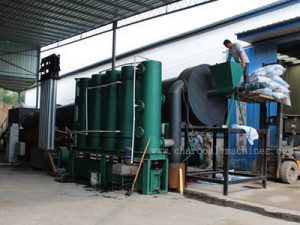Tanuru endelevu la kaboni, wakati ganda la nazi linapochomwa kaboni, lazima kwanza lisagwe na kusagwa kwa kiwango gani. Inaweza kuamuliwa kulingana na mahitaji ya mteja. Hatua inayofuata ni kukausha. Kukausha pia ni muhimu sana. Nyenzo ya jumla ya malighafi iliyochomwa kaboni huchomwa kaboni. Wakati imekauka, vinginevyo, athari ya kuchomwa kaboni si nzuri, kiwango cha kukausha cha ganda la nazi ni karibu 15%-20% ya maji, sio kavu sana. Baada ya kukausha, huchomwa kaboni. Pia ni muhimu sana. Ikiwa kuchomwa kaboni hakudhibitiwi vizuri, inaweza kutupwa, kugeuka kuwa majivu, au haichomwi. Kwa wakati huu, matumizi ya tanuru la kuchoma kaboni ni muhimu sana. Jinsi ya kuiendesha? Kuna mambo kadhaa ya kuzingatia.
1 Kulisha mashine ya kulisha kunapaswa kufanywa kulingana na sehemu ya kuingiza nyenzo ya mashine ya kuchoma kaboni. Hali ya kuanguka huanza na kufunga mashine ya kulisha ili kuongeza nyenzo iliyochomwa kaboni. Nyenzo katika bandari ya chini ya kulisha haiwezi kuwekwa sana. Nyenzo katika bomba la kuchoma kaboni inapendekezwa kuwekwa karibu 2/3.
2 Kasi ya mashine ya kuchoma kaboni inapaswa kurekebishwa kulingana na athari ya kuchoma kaboni, na kasi ya spindle inapaswa kurekebishwa ipasavyo ili kuhakikisha mavuno ya kaboni. (Kasi ya spindle inaweza kurekebishwa)
3 Wakati kuna moshi unaotoka kwenye kiti cha shimoni kwenye ncha zote mbili za shimoni inayozunguka, skrubu ya tezi ya kuziba inapaswa kushinikizwa kwa wakati baada ya kuhama, na kamba ya kufunga ya asbesti ya nyenzo ya kuziba inapaswa kubadilishwa ikiwa ni lazima.


Kujua jinsi ya kuendesha, basi hatua inayofuata ni udhibiti wa joto, kichoma cha kichomeo kinanyunyuzwa, bomba la kuchoma kaboni hupashwa joto, thermocouple huongezwa kwenye mwili wa tanuru, na nafasi ndani ya tanuru huonyeshwa kwenye kifaa cha kudhibiti joto kwenye paneli ya kabati ya kudhibiti kupitia waya. joto. (Joto halisi ndani ya bomba la kuchoma kaboni litakuwa 200~300° juu kuliko joto lililopimwa kwenye tanuru.) Vifaa vya kuchoma kaboni rafiki kwa mazingira, hupashwa joto kwenye tanuru kwa dakika 15-20. Wakati joto linafikia digrii 550-600, bonyeza kitufe cha kuanza cha mashine ya kupakia, screw kwenye mashine ya screw huzunguka, na kulisha mashine ya kulisha huanza kulisha. Nyenzo ya ganda iliyochomwa kaboni itazunguka pamoja na screw ya mashine ya screw. Mwili wa bomba hupanda nyenzo kwenye bandari ya kulisha juu ya mashine ya kuchoma kaboni.
När kokosnötskalets material fylls upp i inloppet av karboniseringsmaskinen, tryck på startknappen för karboniseringsugnen, tryck på den röda strömbrytaren på den elektromagnetiska regulatorn till ON-läget, och vrid långsamt hastighetskontrollratten för att få regulatorn att indikera avböjningsnålen, vilket indikerar att det är cirka 500-600 rpm (lämpligt för kokosnötsskal). Skruven på karboniseringsmaskinen roteras av spiralen, vilket trycker materialet framåt, rör om och flyttar det, i de första och andra karboniseringstuberna i toppen och botten. Förtorkning sker, vattnet i fällningen avleds genom avgasröret. Röken avleds i luften, och materialet är i röret. När en eller två rör är torra och går in i det tredje röret, har vattnet avlagrats och rengjorts. Under lågtemperaturkarboniseringssteget, efter kontinuerlig framsteg, rörelse och omrörning, när det går in i det fjärde röret, vänds, rörs om, drivs och flyttas materialet genom ett avstånd i högtemperaturröret för att slutföra karboniseringen från låg temperatur till hög temperatur. Under karbonkonverteringsprocessen avleds den högtemperaturkol som produceras slutligen från avlastningsporten på karboniseringsmaskinen till inloppet av vattenjackettypens kyl- och avlastningsmaskin, och den högtemperaturkolpulver från avlastningsmaskinens rör kyls av det kylvatten som omger rörkroppen, och slutligen från avlastningsmaskinens avlastningsport Toner och sot efter kylning, som tidigare beskrivits, om och om igen, arbetar kontinuerligt för att slutföra hela processen för karbonisering av kokosnötsprodukter.
